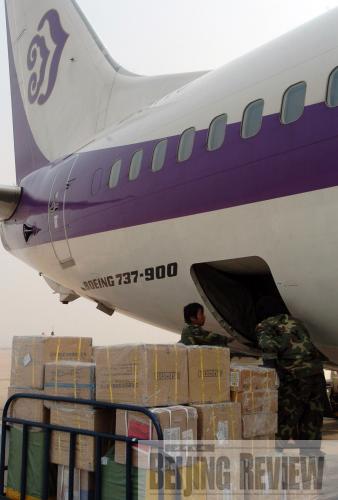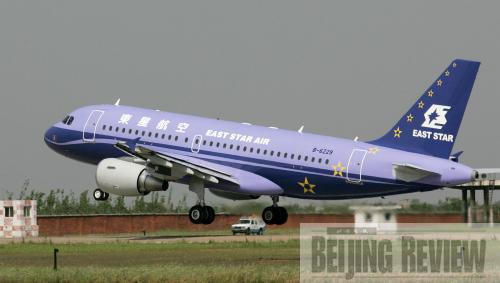|
 |
|
STAYING IN THE AIR: A cargo plane of the privately owned Okay Airways unloads at the Tianjin Binhai International Airport. While private airlines have a history of less than five years in China, their development has been full of hardships (WANG YEBIAO) |
An August 26 ruling by the Wuhan Intermediate People's Court declared the bankruptcy of East Star Airlines Co. Ltd., the first airlines bankruptcy case in China.
Established on May 16, 2005, East Star Airlines is the fourth private airlines to begin flights in China. Opening its first flight from Wuhan, Hubei Province, to Shanghai on May 19, 2006, East Star Airlines had a total registered capital of 80 million yuan ($11.71 million).
The business pattern of "air + travel" held by East Star Airlines had called attention from international capital investors. By the outset of this year, it had leased nine Airbus aircraft, while operating flights between a dozen tourist cities, such as Shanghai, Haikou, Hangzhou, Guilin, Sanya, Hong Kong and Macao.
 |
|
FALLEN STAR: An East Star Airbus 319 aircraft takes off from Wuhan Tianhe International Airport. East Star Airlines is the first carrier to go bankrupt in China (CHU HAO) | East Star Airlines, once the fastest growing private airlines on the Chinese mainland, has been faced with the problem of capital shortages since the outbreak of the financial crisis last year. It was ordered to suspend operation on March 15, 2009.
On August 11, East Star Group, the investment contributor of East Star Airlines, signed a cooperation agreement with China Equity Co. Ltd., a private equity investment company based in Beijing, and formulated a restructuring plan. They applied to the Wuhan Intermediate People's Court for restructuring East Star Airlines against the bankruptcy filings.
Ultimately, the restructuring plan was rejected with a court ruling stating that East Star Airlines had no operating income in 2008, with net profits of -220,169 yuan (-$32,236); China Equity recorded -187,477 yuan (-$27,449) of profits last year.
The court concluded that East Star Group and China Equity, lacking the fund capability to restructure East Star Airlines, would be unable to implement the restructuring plan they had submitted.
Although the restructuring party, represented by China Equity, had promised to invest 200 million ($29.28 million) to 300 million yuan ($43.92 million) for the restructuring plan, it did not specify the source of funding and failed to provide relevant certificates and documents, and lacked measures to protect creditors, the court said.
Short flight
From its grand commencement to bankruptcy, East Star Airlines operated for only four years—a flash in China's overall aviation industry history. But what caused East Star Airlines, once China's fastest growing private airlines, to fall out of the sky so quickly?
According to Zhang Jie, Director of Hubei Shanhe Law Firm who participated in the entire process of the East Star Airlines bankruptcy case, the low access threshold of China's aviation industry is the chief culprit. The aviation industry is an industry of high input but low returns, and a loss of 10 billion yuan ($1.46 billion) a year is not at all unusual. However, the minimum registered capital requirement for an aviation company is just 80 million yuan, only one third of the money needed to buy the cheapest new aircraft. The low threshold of registered capital leads to a shortage of cash flow in the companies' operations. The early failure of East Star Airlines is closely related to its severe shortage of cash flow, Zhang said.
Despite the inadequate cash flow, East Star Airlines made commitments to grandiose projects while seeking instant success. Its primary venture included leasing nine aircraft, paying $100,000 per day for their use. As for business operations, it wholly relied on the personal performance of managers, with no reasonable corporate management structure.
|
